
Concept explainers
Interpretation: The resonance structure of the
Concept Introduction:
- Sometimes the chemical bonding of a molecule cannot be represented using a single Lewis structure. In these cases, the chemical bonding are described by delocalization of electrons and is known as resonance.
- All the possible resonance structures are imaginary whereas the resonance hybrid is real.
- These structures will differ only in the arrangement of the electrons not in the relative position of the atomic nuclei.
To find: The resonance structure of
Answer to Problem 6.62QP
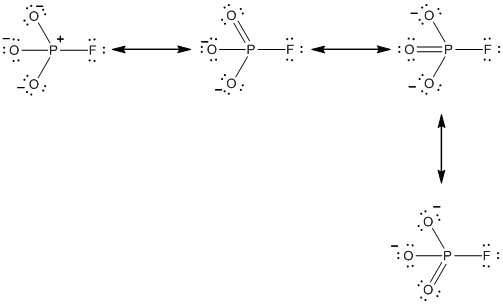
Explanation of Solution
Resonance structure of

In the case of
The resonance structures of the
Interpretation: The formal charges of the
Concept Introduction
- A formal charge (FC) is the charge assigned to an atom in a molecule, irrespective of relative electronegativity by thinking that electrons in all
chemical bonds are shared equally among atoms. - This method is used to identify the most probable Lewis structures if more than one possibility exists for a compound.
- Formal charge of an atom can be determined by the given formula.
Answer to Problem 6.62QP
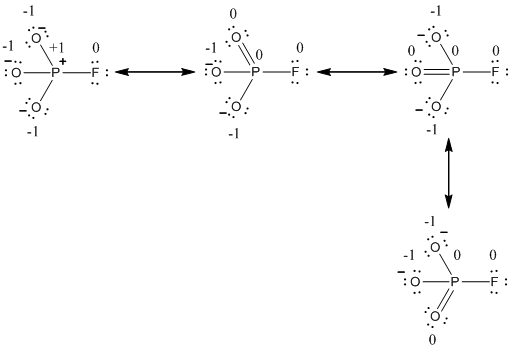
Explanation of Solution
The formal charge of the given resonance structure is given below.
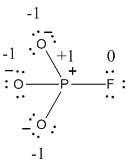
The formal charge of the given resonance structure is calculated,
- Phosphorous atom
Substituting these values to the equation,
- Oxygen atom (a)
Substituting these values to the equation,
- Oxygen atom (b)
Substituting these values to the equation,
- Oxygen atom (c)
Substituting these values to the equation,
- Fluorine atom
Substituting these values to the equation,
The formal charge of the given resonance structure is given below.
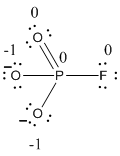
The formal charge of the given resonance structure is calculated,
- Phosphorous atom
Substituting these values to the equation,
- Oxygen atom (a)
Substituting these values to the equation,
- Oxygen atom (b)
Substituting these values to the equation,
- Oxygen atom (c)
Substituting these values to the equation,
- Fluorine atom
Substituting these values to the equation,
The formal charge of the given resonance structure is given below.
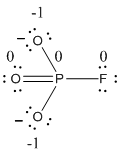
The formal charge of the given resonance structure is calculated,
- Phosphorous atom
Substituting these values to the equation,
- Oxygen atom (a)
Substituting these values to the equation,
- Oxygen atom (b)
Substituting these values to the equation,
- Oxygen atom (c)
Substituting these values to the equation,
- Fluorine atom
Substituting these values to the equation,
The formal charge of the given resonance structure is given below.
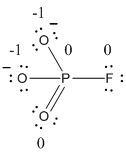
The formal charge of the given resonance structure is calculated,
- Phosphorous atom
Substituting these values to the equation,
- Oxygen atom (a)
Substituting these values to the equation,
- Oxygen atom (b)
Substituting these values to the equation,
- Oxygen atom (c)
Substituting these values to the equation,
- Fluorine atom
Substituting these values to the equation,
The formal charge of the
Want to see more full solutions like this?
Chapter 6 Solutions
Chemistry: Atoms First
- Write all resonance structures of chlorobenzene, C6H5Cl, a molecule with the same cyclic structure as benzene. In all structures, keep the CCl bond as a single bond. Which resonance structures are the most important?arrow_forwardCarbon and sulfur form compounds with each other with the formulas CS2 and C3S2. Draw a Lewis structure for each compound that has a formal charge of zero for all atoms in the structure.arrow_forwardDraw resonance structures for each of these ions: NSO− and SNO−. (The atoms are bonded in the order given in each case, that is, S is the central atom in NSO−.) Use formal charges to determine which ion is likely to be more stable. Explain why the two ions cannot be considered resonance structures of each other.arrow_forward
- Draw Lewis structures for these ions and show which atom (or atoms) in each bears the formal charge. Q.) OH-arrow_forwardDraw the Lewis structure for the nitrate ion, NO3-, with formal charges on each atom and resonance structures.arrow_forwardDraw the structures and assign formal charges, if applicable, to these structures. BH3 and BH4 Draw I with three lone pairs and add formal charges, if applicable. Which atoms have a complete octet? a) The B in BH4 b) iodine c) The B in BH3arrow_forward
 Chemistry & Chemical ReactivityChemistryISBN:9781133949640Author:John C. Kotz, Paul M. Treichel, John Townsend, David TreichelPublisher:Cengage Learning
Chemistry & Chemical ReactivityChemistryISBN:9781133949640Author:John C. Kotz, Paul M. Treichel, John Townsend, David TreichelPublisher:Cengage Learning Chemistry: Principles and PracticeChemistryISBN:9780534420123Author:Daniel L. Reger, Scott R. Goode, David W. Ball, Edward MercerPublisher:Cengage Learning
Chemistry: Principles and PracticeChemistryISBN:9780534420123Author:Daniel L. Reger, Scott R. Goode, David W. Ball, Edward MercerPublisher:Cengage Learning Chemistry: The Molecular ScienceChemistryISBN:9781285199047Author:John W. Moore, Conrad L. StanitskiPublisher:Cengage Learning
Chemistry: The Molecular ScienceChemistryISBN:9781285199047Author:John W. Moore, Conrad L. StanitskiPublisher:Cengage Learning
 Chemistry: An Atoms First ApproachChemistryISBN:9781305079243Author:Steven S. Zumdahl, Susan A. ZumdahlPublisher:Cengage Learning
Chemistry: An Atoms First ApproachChemistryISBN:9781305079243Author:Steven S. Zumdahl, Susan A. ZumdahlPublisher:Cengage Learning ChemistryChemistryISBN:9781305957404Author:Steven S. Zumdahl, Susan A. Zumdahl, Donald J. DeCostePublisher:Cengage Learning
ChemistryChemistryISBN:9781305957404Author:Steven S. Zumdahl, Susan A. Zumdahl, Donald J. DeCostePublisher:Cengage Learning





